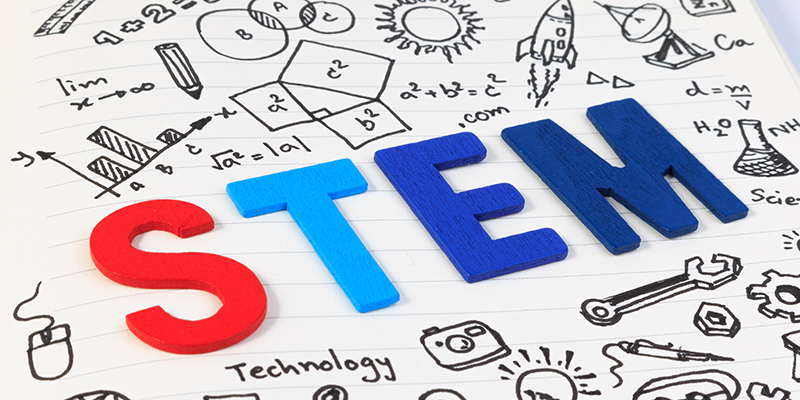Editor’s Note: This post has been updated since it’s original publishing date. We added up-to-date statistics and resources. You may also notice a change in some of the language we use. At Ozobot, we try to regularly assess how the vernacular and ideas we present affect people, especially under-represented communities. In this case, we have made the conscious decision to move away from the tem “special needs” in light of voices in the disability community that have expressed a preference to be referred to as “disabled”—a word to be embraced, not avoided. For more information, visit http://www.aucd.org/docs/add/sa_summits/Language%20Doc.pdf
We all know that STEM education (Science, Technology, Engineering, and Math) is extremely important for today’s students to learn and engage in. Scientific and technological innovations are rapidly increasing in our world every single day. STEM is the next generation’s future and is a huge part of their day-to-day routines.
But what about students with Autism Spectrum Disorder (ASD) and other learning, social, and cognitive disabilities? Can STEM education benefit these students as well? Is access to STEM important for kids with disabilities? The answer is YES! In fact, research shows that students with learning disabilities, if given the opportunity and prepared with the proper knowledge and skills, possess strengths that help them excel in STEM fields.
“It may be that people with autism naturally think like scientists. They look for patterns and, in science, you are always looking for patterns that you hope reflect a natural law,” Simon Baron-Cohen, Director of the Autism Research Center at the University of Cambridge, told Scientific American magazine.
According to research from STEM3 Academy, 35% of students on the autism spectrum choose STEM majors in college. That is twice the amount of general population students. However, 50% of these students lose interest in their STEM pursuits or decide that they are irrelevant to their education or future. Could this be because we are failing to support these students’ interests? Are we underrepresenting STEM subjects for students with disabilities, or failing to teach these subjects in ways that account for different learning styles? Maybe; but new research shows major development in the coming years when it comes to STEM employment for individuals with high-functioning ASD, ADHD, and other learning styles.
When it comes to personality strengths, many employers look for the same few things: attention to detail, loyalty, and reliability. These traits are often common in people with autism, along with extraordinary abilities to remember and recite lists and do complex calculations in their heads. They also tend to dive deep into areas of interest, resulting in encyclopedic knowledge, per Autism Speaks.
Employers in STEM fields are recognizing these traits and hiring more disabled employees. For instance, SAP Software and Solutions put plans into place to hire 650 autistic employees by this year. This makes up 1% of its entire workforce. Microsoft has also launched a pilot program to hire people with autism for full-time positions.
With the growing employment gap in the STEM workforce—there are now one million more computer science related jobs than qualified candidates —initiatives like these could aid in the world’s need for more talented, tech-savvy employees.
Research done by Indiana University indicates that the top jobs for people with learning disabilities include computer programming, engineering/drafting, lab technicians, video game design, and equipment design.
Jenny Miles, a grade school teacher at Emerson Middle School in Pomona, California has been teaching STEM subjects, using Ozobots, to her students with disabilities with great success.
“I have seen their confidence level rise to a point where they truly believe they are as capable as everyone else in the class. The students who only get to be mainstreamed to me (Moderate to Severe) are always asking their main teacher if it’s time to work with computers yet. Order and logic are the comfort zone for many individuals with autism and therefore STEM is a welcoming environment,” she says.
Promoting equity and inclusion is always top of mind here at Ozobot. We recently held a webinar with Ozobot Certified Educator, Frances Amato Dominguez, on supporting equitable distance learning for students with [learning disabilities]. Frances is a New York City STEAM Teacher, working in a district that is a fully SPED district, where all students have an IEP.
“Working with students with autism and multiple disabilities, it can be difficult to find a product that is not only engaging but meets the diverse needs of all of my learners. It is hard to find a product that can be scaffolded to match the goals they have and the support they need, but Ozobot does all of that and more. I have had students disinterested in learning that suddenly, with the introduction of this tiny robot, were motivated to work and figure out the many problems and solutions they can create with it. Students enjoyed making mistakes! It has changed my life, my teaching, and the lives of my students. I could not recommend any item more than I would recommend bringing an Ozobot into the classroom.”
Combine the research with the genuine interest in science and technology, and Ozobot’s STEAM robots that are effective for engaging all learning styles, and we have some serious advancement ahead, not only for people with disabilities, but for the entire STEM workforce. Considering that almost everything we do involves some type of STEM; these future makers, innovators and visionaries can aid in enhancing the world.









